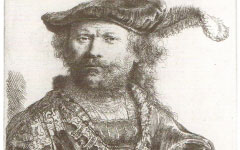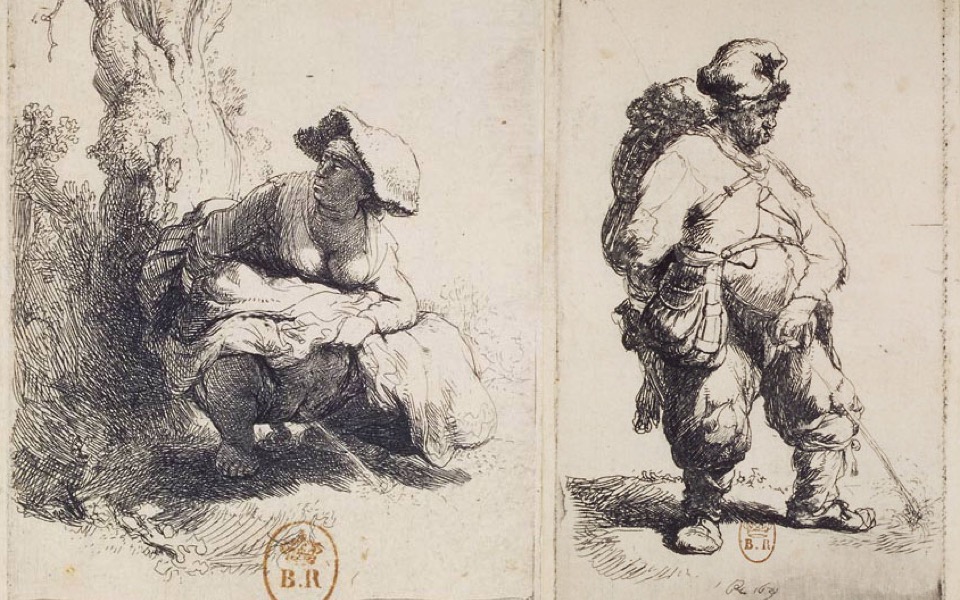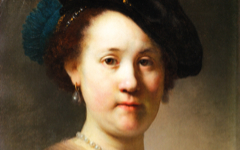Rembrandt’s Beggar in a High Cap (c.1629)

Rembrandt, Beggar in a High Cap, standing and leaning on a stick (c.1629) Etching on paper. Only state.
Click image to enlarge.
All figures in art are an aspect of the artist's self. This little-known but essential feature links artists of very different cultures around a unifying idea. They know this because they themselves always have art on their mind. Rembrandt clearly did. Anyone aware that "every painter paints himself" should have no trouble seeing that the oddly-shaped hat of Rembrandt's beggar......
Click next thumbnail to continue

Left: Detail of Rembrandt's Beggar in a High Cap, standing and leaning on a stick (c.1629)
Right: Greek, Torso of Aphrodite, a detail (c.60 BC) North Carolina Museum of Art, Raleigh.
Click image to enlarge.
.......is in the form of a Greek or Roman torso, headless and limbless. Topped by a fragment of feminine scupture, the artist's androgynous mind thinks 'art'.
Click next thumbnail to continue

Upper L: Rembrandt, Beggar leaning on a stick, facing left, detail (c.1630) Etching. Only state.
Lower L: Belvedere Torso, detail seen from behind
Upper and lower R: Rembrandt, Peasant with Hands behind his back, detail (1631) Signed and dated "RHL 1631". Etching with burin. Fourth state of five
Click image to enlarge.
Knowing this, other hats on Rembrandt's peasants etched in the same years can be seen as antique torsos too. The one at upper left is seen from the back; the short, thick vertical line in the center is a shadow near the torso's spine. This hat resembles a feminine version of the Belvedere torso (lower left) in a rear view. The hairy hat on the right is torso- and breast-shaped as well with the breast in profile facing leftwards. Perhaps the hat's hirsute texture is intended to convey androgyny.
Click next thumbnail to continue

Upper L: Detail of Rembrandt's Beggar in a High Cap
Lower L: Diagram of detail above
Upper and lower R: Detail of Rembrandt's Self-portrait with a Gorget (c. 1629)
Click image to enlarge.
The trio of prints, however, are more than a hat trick. These peasants not only conceive new artworks in their heads but are, as artworks themselves, being conceived...by Rembrandt. In a fragmentary, proto-Cubist appearance Rembrandt's own face is suggested in our first print, in the scratched lines of the beggar's clothing. His veiled "eye" is symbolically constructed out of the beggar's hands (see diagram, lower left) to signify, as always, the unity of craft and perception. While the "beggar", like an artist, picks up odds and ends for use elsewhere and thinks about ancient art, Rembrandt himself is conceiving the beggar as his own self-representation. He appears out of "Rembrandt's own head."
Click next thumbnail to continue
If we "see" this early etching by the wise young artist in the proper perspective, we see that moment when the work itself was created, a moment forever present in an endless "now". In his own way Rembrandt advises us, along with philosophers from almost all the world's major traditions, that the only moment that ever really matters is the present one. Be awake in the present, he advises us. This little etching is, like so much great art, full of wisdom for minds in search of truth.
More Works by Rembrandt
Scholars have long wondered why Rembrandt would represent himself in expensive and extravagant clothing from a century earlier even though they know that the etched self-portrait is based on an engraving of the fifteenth-century painter Jan Gossaert, known as Mabuse.

Rembrandt’s Self-portrait in Sixteenth-Century Costume (1638)
Notes:
Original Publication Date on EPPH: 29 Mar 2013. | Updated: 0. © Simon Abrahams. Articles on this site are the copyright of Simon Abrahams. To use copyrighted material in print or other media for purposes beyond 'fair use', you must obtain permission from the copyright owner. Websites may link to this page without permission (please do) but may not reproduce the material on their own site without crediting Simon Abrahams and EPPH.


